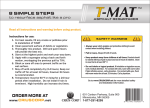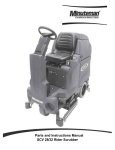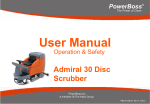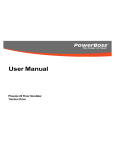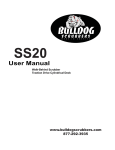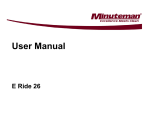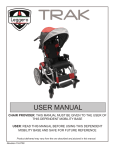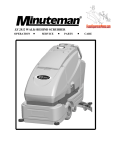Download ES2832 P&I MANUAL
Transcript
PHOENIX 30/34 WALK-BEHIND SCRUBBER •User Manual This manual is for the POWERBOSS PHOENIX 30/34 This manual provides the necessary operating and preventive maintenance instructions. Operators must read and understand this manual before operating or servicing this machine. This machine was designed to give you excellent performance and efficiency. For best results and minimal cost, please follow the general guidelines below: Operate the machine with reasonable care. Follow the manufacturers suggested maintenance instructions as provided in this booklet. Use original PowerBoss supplied parts. TECHNICAL SPECIFICATIONS Model Model No. Current Voltage, Batteries Battery Capacity Sound Level Dimensions (LxWxH) Gross Weight Working Grade Transport Working Grade Cleaning Inflate Wheel Pressure to PHOENIX PHOENIX 30/34 70 Amps 36 volts, 6-6volt 275 AH 72dB 66” x 44” x 47” (167.64cm x 111.76cm x 119.38cm) 1,020 lbs (462.66 kg) with batteries 614 lbs (278.51 kg) without batteries 16% (10° ) 10% (7° ) 50 PSI (Front Wheel) IMPORTANT SAFETY INSTRUCTIONS Operators must read and understand this manual before operating or maintaining this machine. Do not operate this machine in flammable or explosive areas. This machine is designed solely for scrubbing dirt and dust in an indoor environment. PowerBoss does not recommend using this machine in any other capacity. The following information below may cause a potential hazard to the operator and equipment. Read this manual carefully and be aware when these conditions can exist. Take necessary steps to locate all safety devices on the machine and train the personnel operating the machine. Report any machine damage or faulty operation immediately. Do not use machine if it is not in proper operating condition. FOR SAFETY DURING OPERATION: Keep hands and feet clear of moving parts while machine is in operation. Make sure all safety devices are in place and operate properly. All covers, doors and latches must be closed and fastened before use. During operation, attention should be paid to other persons in the work area and especially if small children are present. Electric motors and components can cause an explosion when operated near explosive materials or vapor. Do not operate this machine near flammable materials such as solvents, thinners, fuels, grain dust, etc. Store or park this machine on a level surface only, with parking brake engaged. To prevent unauthorized use, machine should be stored or parked with the key removed. This machine is designed for level operation only. Do not operate on ramps or inclines. This machine is not suitable for picking up hazardous dusts. Use caution when moving this machine into areas that are below freezing temperatures. Any water in the tanks or hoses can cause damage to the machine. FOR SAFETY WHEN SERVICING or MAINTAINING MACHINE: Stop on level surface. Disconnect the power to the machine by pulling the large red handle (Anderson Plug) located in the back of the machine, mid-right, when charging batteries or during installation or removal of brushes. Avoid moving parts. Do not wear loose jackets, shirts, or sleeves when working on machine. Avoid contact with battery acid. Battery acid can cause burns. When working on or around batteries, wear protective clothing and safety glasses. Remove metal jewelry. Do not lay tools or metal objects on top of batteries. Charging batteries generates explosive gasses. Do not charge batteries when open flames or sparks are present. Do not smoke. Make sure the charger is turned off before disconnecting it from the machine. Charge the batteries in a well-ventilated area with the battery cover removed completely. Do not clean machine with a pressure washer. Authorized personnel must perform repairs and maintenance. Use PowerBoss supplied replacement parts. SAVE THESE INSTRUCTIONS 3 INSPECTION Carefully unpack and inspect your Phoenix walk behind scrubber for shipping damage. Follow unpacking instructions on shipping pallet. Each unit has been tested and thoroughly inspected before shipment. Any damage is the responsibility of the delivery carrier who should be notified immediately. ELECTRICAL This machine is battery operated and designed to operate on 36 volts DC (6) 6-volt batteries. BATTERIES The recommended batteries are rated 275Ah (P/N 956740). We do not recommend mixing AMP hour capacities. Any alternate battery sets can be used if they equal physical size and capacity. See page 13 for service and installation. OPERATOR RESPONSIBILITY Read this manual carefully before operating this machine. The operator is responsible in taking care of the daily maintenance and check ups of the machine to keep it in good working condition. The operator must inform the service mechanic or supervisor when the scheduled maintenance intervals are required as stated in the MAINTENANCE section of this manual. Before starting familiarize yourself with the machine and its controls (see “Machine Overview, Front”, “Machine Overview, Rear”, “Operator Compartment”, “Control Console” diagrams). MACHINE COMPONENTS FRONT A ROLLER BUMPERS B RECOVERY TANK C SOLUTION TANK D FRONT WHEEL E REAR CASTER F REAR SQUEEGEE G CONTROL CONSOLE H CUP HOLDER I VACUUM COVER J TANK LID K DUMP CAP COVER I H G J B C K F A E D 4 MACHINE COMPONENTS REAR A CONTROL CONSOLE B REAR SQUEEGEE C SCRUB DECK D SOLUTION DUMP HOSE E RECOVERY DUMP HOSE F ANDERSON PLUG G DIRECTIONAL SWITCH A G I HOUR METER H D E EMERGENCY BELLY BAR I F H C B MACHINE COMPONENTS CONTROL CONSOLE A ACCELERATION LEVER B SPEED CONTROL KNOB C DIRECTIONAL LEVER D DIRECTIONAL INDICATOR E KEY SWITCH F EMERGENCY BELLY BAR G OFF-AISLE WAND SWITCH H E D C A J I B A BATTERY GAUGE I SOLUTION CONTROL J MODE SELECTOR H F 5 G THE CONTROL CONSOLE For operator ergonomics, the control console houses all the primary function buttons are grouped in a central area. The key switch, main keyboard, directional switch and off-aisle wand switch are clustered in the back area. The directional switch (forward and reverse) is located in front of the console for easy fingertip operation. Accelerator Lever (A) Enables the machine to move forward or backwards once depressed. Speed Control (B) This knob controls the rate at which the machine moves. Turning the knob clockwise will increase the speed. Turning the knob counter-clockwise will decrease the machine speed. Directional Switch (C) When you flip the switch down, the machine moves backwards or flip the switch upward, the machine will go forward. Directional Indicator (D) This indicator displays which direction the Phoenix will travel once the Accelerator Lever is depressed. A light is available for each direction. Amber when set to forward. Red when set to reverse. Key switch (E) Controls the machine’s power (On/Off) with a key for safety. All operational settings are retained even when the power is turned off and on. This also serves as a reset switch when error or fault codes. Emergency Belly Bar (F) If this bar is to be depressed it will override the directional switch and force the Phoenix to go forward. Most useful if backed into a corner or object to prevent from pinching the operator. Off-aisle wand switch (G) On/Off control for the water supply to the wand and vacuum motor. If the switch is in the On position it will force the battery gauge to blink 6 LEDs to signify the wand is currently on. Battery Gauge (H) This gauge displays the remaining battery life. The gauge has a readout of 10 LEDs. 3 Green, 4 Amber, 3 Red. This gauge will also display the fault code if the system has an error represented by the number illuminated flashing LEDs. See Fault/Diagnostics Codes below for specific code. If the battery life is low the battery gauge bar icon will be flashing to signal the operator that the machine is almost out of power. Once this signal is displayed to the operator, all functions will shut off including the transport mode. The operator has to turn the key switch OFF and then, ON to reset the machine. The machine then will only have a few minutes left of reserve power for a short Vacuum only mode to pick up remaining solution on the floor and Transport power. Solution Control (I) This knob controls the rate at which solution is put down. Turning the knob clockwise will increase the amount of solution put down. Turning the knob counterclockwise will decrease the solution rate. The knob can be adjusted between 0.25 gpm up to 1.1 gpm. 6 Mode Selector (J) This switch will toggle between one of the five cleaning modes available on the Phoenix 30/34 CLEANING MODES 1. REGULAR SCRUB MODE When the machine is running in this mode, the machine will perform all operations. This mode can be used for day-today tasks under normal conditions. When the operator sets the directional switch to forward and activates the accelerator handle, the solution pump will turn on, the brushes will turn on and be lowered to the floor, as well as the rear squeegee. While operating in this mode, the solution will be dispersed into the brushes, which will scrub the floor allowing the chemical in the solution to break down the dirt on the floor. As the machine continues to move forward, the rear squeegee and vacuum system will recover the dirt and dispensed solution. If the operator stops moving, the machine will automatically raise the scrub deck and turn off the brushes. If the directional switch is changed to reverse the machine will continue to operate normally, only the rear squeegee will raise up. 2. HEAVY SCRUB MODE This mode is similar to Regular Scrub. The machine will continue to operate the same was as if it was in Regular Scrub Mode, only this mode applies more solution and brush pressure is increased. This mode is used for high traffic areas and areas that have been heavily soiled, but do not require time for the solution to soak. 3. DOUBLE SCRUB MODE When the machine is running in this mode, the machine will perform all operations except dirty solution recovery. This mode can be used if the floor is heavily soiled and the chemical will need additional time to emulsify grease and oils that are on the floor. When the operator sets the directional switch to either the forward or reverse position and activates the accelerator lever, the solution pump will turn on, the brushes will turn on and be lowered to the floor. While operating in this mode, the solution will be dispersed into the brushes, which will scrub the floor allowing the chemical in the solution to break down the dirt on the floor. As the machine continues to move forward or back, the rear squeegee and vacuum system are not on, which allows the solution to stay on the floor emulsifying the grease and oil. If the operator stops moving in either direction, the machine will automatically raise the scrub deck and turn off the 7 brushes. After double scrubbing, the operator should use the vacuum only mode to recover the dirty solution water from the floor. 4. VACUUM ONLY MODE When the machine is running in this mode, the machine will only lower the rear squeegee and turn on the vacuum system to recover the dirty solution from the floor. This mode is usually chosen after double scrubbing to recover the dirty solution but it can also be used to pick up spills. When the operator sets the directional switch to forward, the rear squeegee will be lowered to the floor as the vacuum turns on, pulling the dirty solution water from the rear squeegee into the recovery tank. If the operator stops moving forward and sets the directional switch to reverse, the rear squeegee will retract (protecting it from damage) and the vacuum motor will turn off after a few seconds. If the operator quits moving in either direction, the machine will automatically raise the squeegee and turn off the vacuum motor after a few seconds. 5. TRANSPORT MODE When the machine is set in this mode, none of the cleaning functions of the machine will operate. This mode is only used to transport the machine from one location to another at a faster rate of speed. 6. WATER FLOW Located on the left side of the control console. This knob controls the rate at which water / solution is distributed to the scrub deck. The farther the knob is turned clockwise the more water will be distributed. 7. SPEED CONTROL Located on the right side of the control console. This knob controls the propelling speed of the machine. The farther the knob is turned clockwise the faster the machine will travel. As discussed earlier, the directional switch governs the direction of travel the machine will take. OPERATION OF CONTROLS POWER SAVE MODE The Phoenix is equipped with a power save feature to conserve battery power. If the key switch power is left ON and none of the controls are activated for a period of fifteen minutes, the Phoenix automatically goes into “power down mode” and turns OFF the power to conserve your batteries in case the operator forgets to turn the key switch off or leaves the machine unattended. 8 EMERGENCY DISCONNECT HANDLE This handle is located beneath the control console off center to the right. When the red emergency handle is pulled, power will be turned off. Use this button in case of a machine emergency. To reactivate, return the handle back to its original position, correctly seated in the receptacle. All operational settings are retained even when the power is turned off and on. CIRCUIT BREAKER The circuit breaker is located under the emergency belly bar. The 100-amp breaker protects the main system circuit (controller). Each main component is individually protected with an internal breaker builtin the controller. (See fault code table) and can be reset by turning the key switch off a few seconds and then on again. BATTERY COMPARTMENT The battery compartment is located on the rear of the machine under the recovery tank. Unlatching the two safety latches on the side of the machine enables the operator to tilt the recovery tank and access the batteries for servicing and maintenance (make sure recovery tank has been drained before tilting). The battery compartment contains six 6-volt batteries connected in series. Connect the batteries according to the battery connection diagram (see diagram). The recommended batteries are 275Ah (P/N 956740). 9 SCRUB DECK PowerBoss offers two deck types (Cylindrical and Disc) to fit your specific needs. The Phoenix design is very dynamic wherein the decks are interchangeable in a matter of minutes whenever necessary (removal of four bolts, and two quick-connects). The cylindrical brush deck has five built-in spray jets to uniformly dispense cleaning solution on the floor and a wet sweeping debris tray to collect loose objects on the floor. The disc brush deck dispenses cleaning solution through the center hub and contained within the bristle area for efficient agitation of cleaning solution to the floor and channeled to the rear of the machine. The disc brushes are also easily removed and installed with the quick release clamp by using any of the three access doors. Another nice feature that these scrub decks have is the ability to have uniform brush pressure applied to the floor at all times. Since the scrub deck brush pressure is computer controlled, it will automatically adjust and compensate to uneven contours on the floor while maintaining brush pressure. CYLINDRICAL SCRUB DECK A B C D E F G H I J K L M Housing Spray jets (5) Access door (2) Nut, Access door Debris box Connector, water Mounting bracket Connector, power Brush motor (2) Pulley cover (2) Bolt (4) Lock washer (4) Flat washer (4) 10 DISC SCRUB DECK Housing Access door (6) Brush skirt Brush motor Mounting bracket F Flat washer (4) G Lock washer (4) H Bolt (4) I Connector, power J Connector, water A B C D E SCRUB DECK INSTALLATION When installing a cylindrical scrub deck to a machine: Install brushes after the deck has been mounted to avoid flat spots on the brushes. Use a piece of cardboard underneath the deck to prevent scratches to the painted surface when sliding the deck under the machine. Make sure the scrub deck is oriented correctly with the spray jets towards the front of the machine. When installing a disc scrub deck to a machine: Install brushes on the scrub deck; this aids the installer in sliding the deck assembly into position. Make sure the scrub deck is oriented correctly with the solution hose tee fitting towards the front of the machine. INSTALLATION INSTRUCTIONS Park the machine on a flat or level surface. Remove the 2 pins that fasten the deck cover on the machine. Turn the key switch to the ON position and select the transport mode on the dashboard. Slide the scrub deck assembly underneath the machine (follow instructions as described above). Position the scrub deck to align the mounting brackets with the mounting lugs on the lift linkage. Lower the lift linkage to the floor by pressing the raise/lower deck button. Lower the lift linkage mounting lugs until they barely touch the scrub deck mounting brackets. 11 Fasten with the four (4) 711242 bolts, 711515 flat washer and 711546 lock washer. For cylindrical scrub deck only: Remove the two access doors (one each end) by removing the (3) nyloc nuts. Install the brushes by sliding through the access opening. Align the notches on the brush with the drive pins on the hub. Push brush all the way until it bottoms out. Insert access door hub to the other end of brush. Reinstall nuts and tighten. 12 REAR SQUEEGEE The rear squeegee is the main element that acts as the conduit that transfers the spent solution into the recovery tank. A daily maintenance check of this component is essential to have optimum machine performance. The rear squeegee assembly is equipped with a universal front blade that allows the operator the option to use a slotted and a non-slotted side for specific applications. Each blade configuration has two usable edges. The rear blade however has four usable edges. The squeegee is pre-adjusted at the factory. Adjustments may be required to get optimum performance for different floors and conditions. Q G N H I J E D C P O B G A L M K REAR SQUEEGEE COMPONENTS A. Rear squeegee blade B. Wing jam nut (2) C. Swivel Caster (2) D. Lock Nut E. Turnbuckle F. Front squeegee blade G. Wing bolt (2) H. Toggle clamp I. Front strap (long) J. Front strap (short) K. Rear strap (latch side) L. Rear strap (catch side) M. Latch N. Guide wheels (2) O. Nylon wing bolt (2) P. Nylon bolt (2) Q. Recovery hose intake 13 REAR SQUEEGEE ADJUSTMENT Ensure that the scrubber is on a relatively flat surface. Turn on the key switch and select the Vacuum only mode. This lowers the squeegee to the floor and turns the vacuum motor on. Move the scrubber one or two feet forward slowly while someone behind the machine checks the rear squeegee blade (item A) for uniform deflection to the floor. If uneven deflection or lay is evident, minor adjustments may be necessary to avoid streaking and uneven wear on the blade. To correct this, loosen the wing jam nut (item B) in order to adjust the caster height. If the squeegee blade is deflecting too much, the casters (item C) need to be lowered to control the down pressure. Lower the caster by turning the exposed threaded stem on the caster clockwise. Make the adjustment a few turns at a time. Repeat step 2. If the blades are not deflecting enough, raise the caster by turning the stem counter-clockwise to adjust the caster height to allow more down pressure on the squeegee. Repeat step 2. Make sure there is even deflection on the entire length of the rear blade. Adjust the casters and retighten the wing jam nuts to lock the caster setting in place. Pitch adjustment is necessary if the outer ends on the squeegee blade do not contact the floor and there is too much deflection in the middle area or if the outer ends are over deflected and there is no contact in the middle. To adjust the pitch, repeat step 2. Loosen the lock nut (item D) in the turnbuckle assembly. Turning the turnbuckle (item E) clockwise or counter-clockwise controls the forward and backward pitch of the squeegee. Having the rear blades deflected uniformly along its entire length is the desired set-up. Repeat step 2 until desired set-up is achieved. In certain applications where a non-slotted front wiper blade (item F) is needed, detach the rear squeegee assembly by loosening the two wing bolts (item G). Unlock the toggle clamp (item H) on the front squeegee to release the front long strap (I) and slide the front short strap (item J). Flip the blade over to the non-slotted side. Reattach the straps and lock the clamp back in place. You can also easily replace the rear blade by unlatching the latch (item M) and removing the two rear straps (items K & L) by sliding them off the assembly. You can then flip the blade over in order to use a new edge for better wiping action. 14 OFF-AISLE WAND (optional) The Phoenix is equipped with a ready-to-use built-in telescoping off-aisle wand system for use in hard to reach areas. This integrated system eliminates attaching hose for use and detaching hoses for storage. By turning the pump switch ON (located behind the right handle of the control console) the off-aisle wand is ready to use in seconds. After use, simply flip the switch OFF and return the wand to it’s original storage location. The wand is also equipped with the patented flip-flop tool that allows the operator to switch from scrub brush to squeegee tool by just rotating the tool end. OFF-AISLE WAND TOOL The off-aisle wand tool as described in the previous page is composed of the following items: The recovery hose is connected to the end of the wand on one end and to the recovery tank hose on the other end. This hose has swivel cuffs on both ends that allow the operator a good range of motion and the solution hose to be inside the recovery hose. The trigger controls the solution flow to the spray jet. Squeezing the trigger opens an internal valve to dispense cleaning solution. The coiled solution hose acts as a conduit from the trigger to the spray jet, and allows hose to be extended along with the wand. The spray jet dispenses the cleaning solution to soak soiled areas that are not accessible to the main scrub deck. The telescoping wand allows the length to be adjusted for operator comfort and better storage when not in use. Sliding the wand extender forward (as shown above) extends the wand length during use and retracts the wand by pulling it back for the storage position. The flip-flop tool gives the operator complete flexibility when changing from the scrub brush mode to vacuum squeegee mode by simply rotating the end. When the off-aisle wand switch is turned ON, six LEDs on the battery gauge will flash to indicate that you are in the off-aisle tool mode. This switch turns on the pump to supply solution to the wand spray jet and the vacuum motor to recovery the dirty water. 15 The Phoenix 30/34 This machine was designed with total operator comfort and ease of use in mind. All machine components have been designed as a total system to efficiently clean dirty floors. The Phoenix has four available scrub head types and sizes to fit specific applications. Please contact your PowerBoss representative for specific recommendations for the correct scrub head type, size, and brush type and chemical applications. Before using the machine, always perform the following steps to ensure proper machine operation. Check under the machine for leaks. Check the rear squeegee for wear and damage. Check the solution and recovery tank levels. After using the machine, always perform the following steps: Check the battery charge level. Charge batteries if necessary. When charging batteries, extra precaution is required: Battery acid can cause burns. When working on or around batteries, always wear protective clothing and safety glasses. Remove metal jewelry. Do not lay tools or metal objects on top of the batteries. Charging batteries generate explosive gasses. DO NOT CHARGE BATTERIES WHEN OPEN FLAMES OR SPARKS ARE PRESENT. DO NOT SMOKE. Make sure the charger is turned off before disconnecting it from the batteries. Charge the batteries in a well-ventilated area. Fluid levels should be checked before and after charging and maintained at the proper levels. If low, add distilled water until the metal plates are covered. If the machine is not used for an extended period of time, batteries should be kept fully charged with a boost charge once a week. Check for wire, string, or twine wrapped around the scrub brushes. Check the rear squeegee for wear and damage. Check the rear squeegee suction hose and off-aisle wand hose for obstructions. Empty and clean the debris box (cylindrical systems only). Drain and clean the recovery tank. Check under the machine for leaks. Check the service records to determine maintenance requirements. WARNING! Be sure you understand the machine controls and their functions. While on ramps or inclines, avoid sudden stops when tanks are filled. Avoid abrupt sharp turns. Slow down driving speed when going downhill. MACHINE OPERATION Follow the instructions in preparing the machine for use as described in this manual. Turn the Key switch ON (I). The Battery Gauge will light up for a few seconds then display the Battery Condition. Do NOT attempt to operate during this time. Select one of the five available Modes on the Control Console for the required task. Refer to the Main Keyboard section of this manual for a complete description of the functions. Determine the direction you need to travel by selecting forward or reverse on the Directional Switch. Vary the acceleration knob to propel the machine at the desired speed. 16 Squeezing the Accelerator Handle turns on the Transport, Brushes, Water Flow, Vacuum and lowers the Rear Squeegee accordingly to the Mode selected. If the operator triggers the accelerator handle before, or turns the key switch “ON” at the same time, the machine will not move as a safety precaution. Simply release the handle and squeeze the handle again to drive the machine. Please refer to the Main Keyboard section of this manual for a complete description of the functions. When Reverse is selected on the Directional Switch, the Rear Squeegee automatically is raised. However, the Scrub brushes will continue to rotate and solution will continue to flow. Start scrubbing by driving the machine forward in a straight line at 3/4 speed and overlap each path by 2 to 3 inches. Adjust your speed and solution flow according to the condition of the floor. When scrubbing, check behind the machine occasionally to see that all the dirty water is being picked up. If streaking occurs, your Water Flow setting may be too high, the Recovery Tank may be full, the Squeegee hose may be clogged, or the Rear Squeegee may require some adjustment or cleaning. Make the necessary adjustments on the Rear Squeegee if streaking occurs both in straight paths and in turns. Please refer to the Rear Squeegee section of this manual before making any adjustments. The recovery tank has an overflow protection to guard against water from entering the vacuum system when the recovery tank is full. A ball float shut-off system has been integrated into the Recovery Tank. When the dirty water reaches a certain level, the ball gets suctioned into the vacuum manifold and blocks the airflow thus, preventing the machine from picking up more liquid. When this happens, the operator is then required to stop scrubbing and empty the recovery tank. To stop scrubbing, select the Transport mode. This will automatically stop the Solution Flow, raise the Scrub deck, and raise the Rear squeegee (there is a 15 second delay for the vacuum motor and a 8 second delay on the rear squeegee). Drive the unit to a designated dirty water disposal area and empty the Recovery tank. To empty, remove the Drain hose from its storage hanger. Unscrew the plug and hold the hose end above the water level in the tank to avoid sudden, uncontrolled flow of dirty water. With the plug completely off, carefully direct the water flow to the desired drain. Reinsert the plug and tighten and return to its storage hanger. The recovery tank should be rinsed out to remove solids in the tank. Open the Cleanout cap to remove the Stopper plug. Tilt the recovery tank (similar to accessing the batteries) and clean the sludge that has settled in the sump area by either back flushing or by scraping it out. Be sure to tightly secure the Stopper plug and cleanout cap before continuing to operate the scrubber. Refill the solution tank and continue scrubbing until the job is done or when the machine runs out of power. The battery gauge bar icon will flash to signal the operator that the machine is almost out of power. Once this signal is displayed to the operator, all functions will shut off (brush will turn off and the scrub deck will raise up, water flow will cease, the rear squeegee will raise up and the vacuum motor will turn off) including the transport mode. The machine then will only have a few minutes left of reserve power for a short Vacuum only mode to pick up remaining solution on the floor and Transport power to drive to the battery recharging station. AFTER USE: When finished scrubbing, select the Transport mode, all functions will shut off (brush will turn off and the scrub deck will raise up, water flow will cease, the rear squeegee will raise up and 17 the vacuum motor will turn off). Drive the machine to a service area for daily maintenance and review items that may need service. Empty the solution tank, by opening the solution hose valve into a drain. Rinse the tank with clean water to prevent any build-up of dried up chemicals that could cause clogging in the plumbing. Empty the recovery tank as described on line 11 and 12. Remove the brushes or pad holders and rinse them in warm water and hang to dry. Remove the rear squeegee, rinse with warm water and reinstall after cleaning. Check the maintenance schedule on the next page and perform any required maintenance before storing the machine. Store the machine indoors in a clean dry place. Keep from freezing. Leave solution and recovery tank lids open for ventilation to prevent odor build-up. Turn Key switch OFF (O) and remove key. MAINTENANCE SCHEDULE Daily Weekly Charge Batteries Check Each Battery Cell(s) Water Level Monthly Lubrication – Grease Fittings, chains, etc. Yearly Check Carbon Brushes Check/Clean Tanks Inspect Scrub & Hoses Housing Skirts Check/Clean/Rotate Inspect and Clean the Brushes/Pads Solution Filter Check/Clean the Clean Spray jets on Squeegee Cylindrical System Check/Clean Vacuum Shut-Off Float Check/Clean the Vacuum Motor Foam Filter Clean Hopper on Cylindrical System Check the vacuum motor carbon motor brushes once a year or after 300 operating hours. The brush motor carbon brushes should be checked every 500 hours or once a year. NOTE: Refer to the Service Manual for more detail on maintenance and service repairs. LUBRICATING THE MACHINE Regularly scheduled lubrication of certain machine parts should be performed to insure trouble-free operation of the machine. Apply a generous amount of grease into the fittings on the machine until grease seeps out around the bearings. The grease points are listed below: Rear squeegee caster wheel axle (2) Rear squeegee caster wheel stem (2) Apply lubricant or light machine oil to lubricate the: Rear squeegee general pivot points Scrub deck linkages Drive wheel assembly seals. 18


















